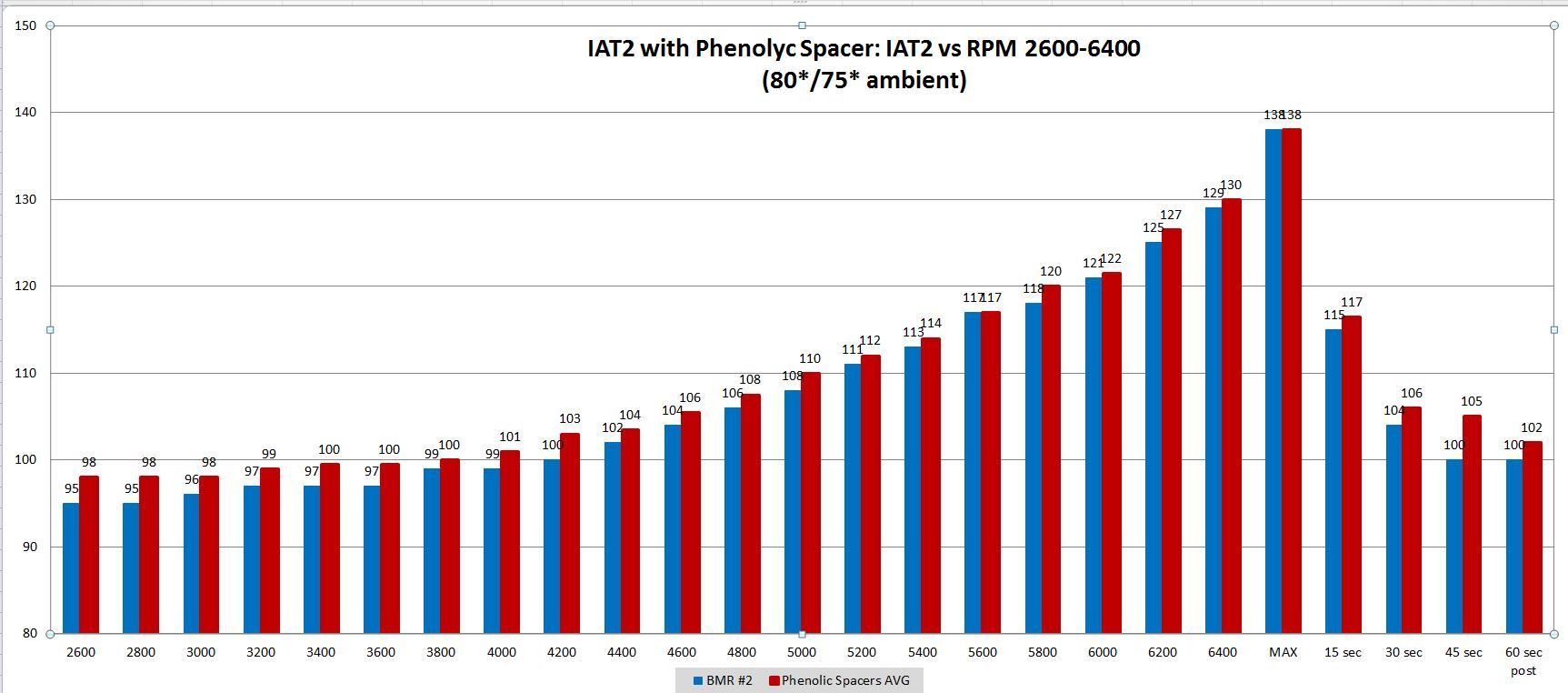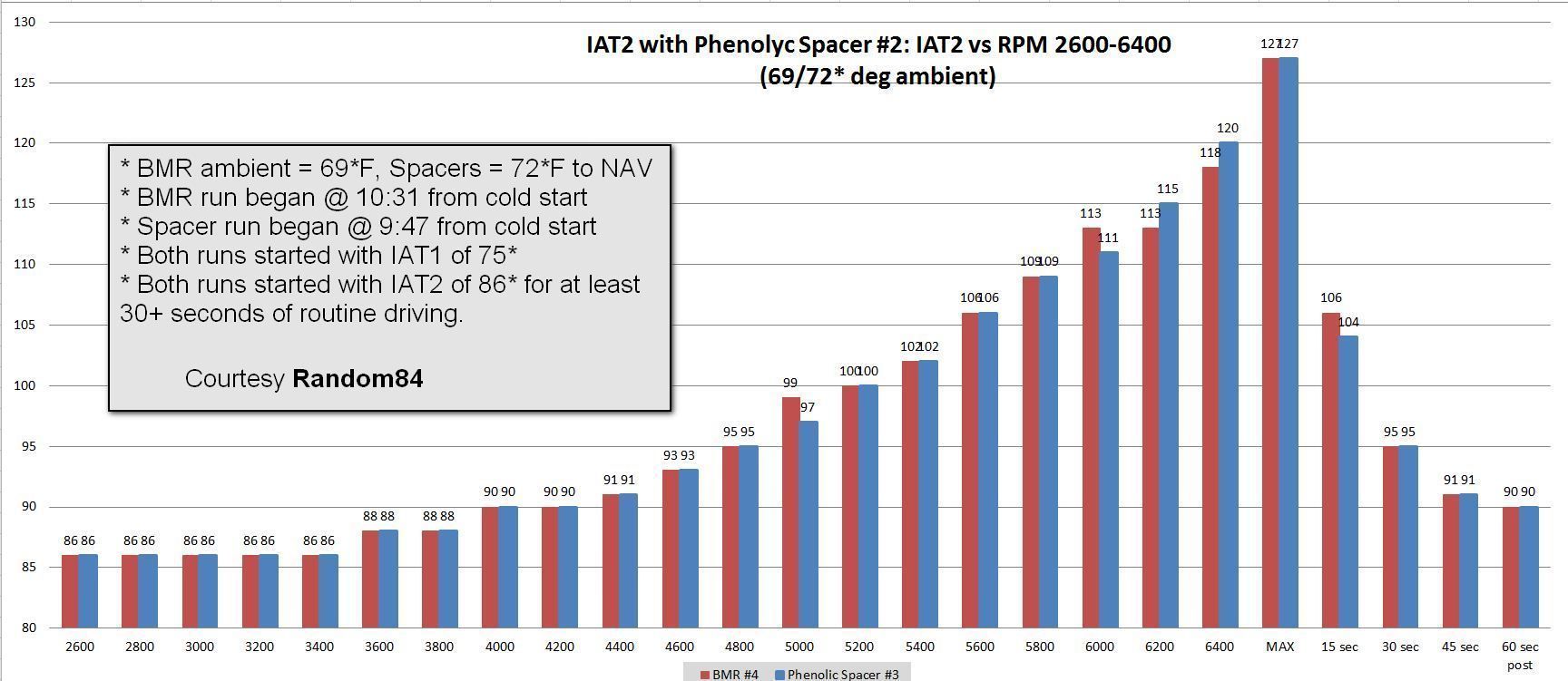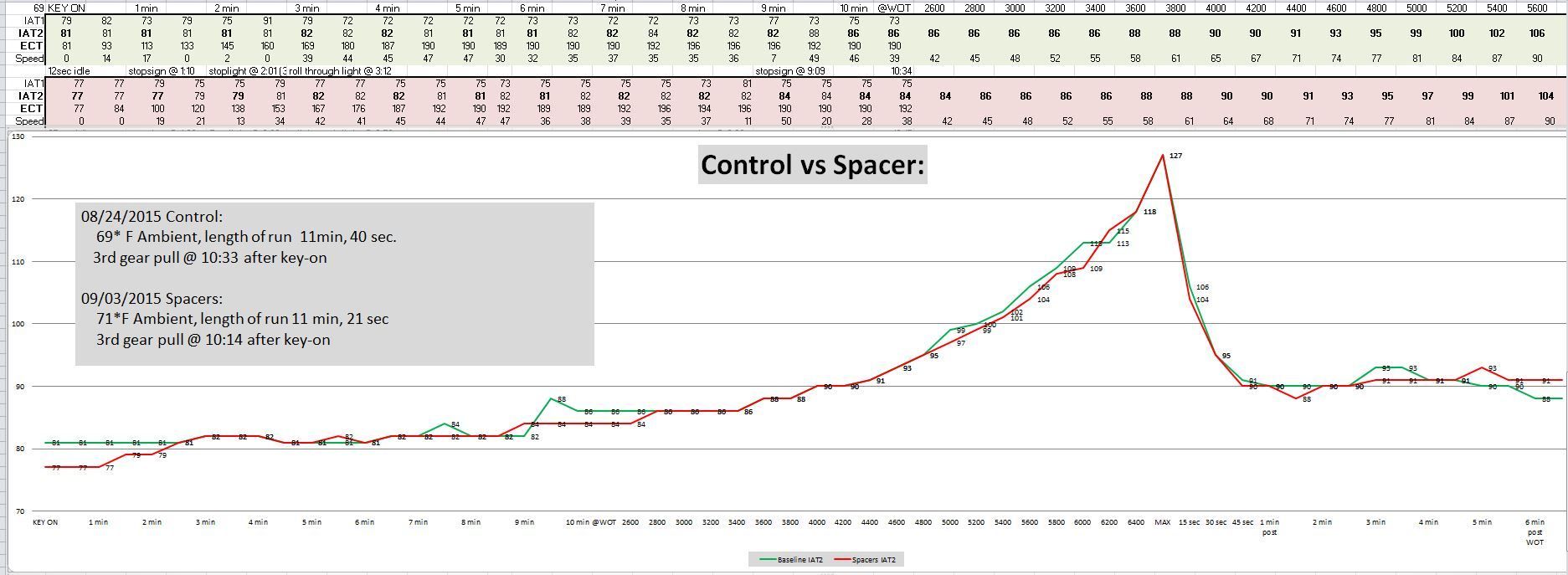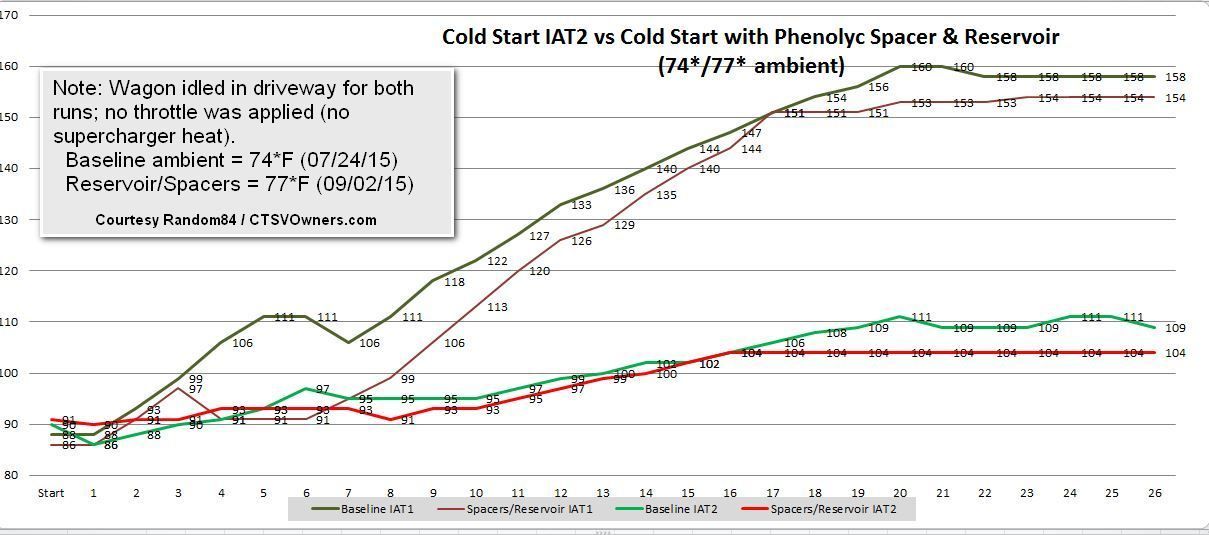[ZR1] My experience with Phenolic Spacers (lots of data inside):
#1
Safety Car


Thread Starter
I have a 650 RWHP "5-door ZR1." I was interested in the claims made for phenolic (nylon) intake manifold spacers typically advertised for both the ZR1 and CTS V platforms; so I purchased a set with the intention of trying to compare the gains from this modification. My results are below, and although I tried to be as thorough as possible... at the end of the day, I'm just some guy on the internet. Your mileage may vary.
--------------------------------------------------
Background:
Per the manufacturer:
I purchased a pair of these 3/16" spacers with a thermal blanket that goes into the lifter valley at full retail price. I specifically datalogged extensively prior to the installation with the explicit purpose of seeing if they offered me any advantage on my daily driver CTSV.
-----------------------------------------------------
Methods:
The test Circuit was 13.3 total miles, a route I often take going to work in the morning. Runs are from Cold start in AM, normal driving (little to no boost) to RB Road, allowing for full warm-up within 5-10 minutes during summertime. A 3rd gear pull from 2500 RPM to 6400 RPM (~35-100mph) on the same stretch of road, then normal driving to interstate for another ~3miles of driving at 70mph to monitor IAT2 over ambient temperatures. Logging will end at that point.
Vehicle: CTSV Wagon, 6 speed manual (TVS1900 blower). Modest cam and pulley but stock block and heads with springs & trunion upgraded. Existing cooling mods are typical for the CTSV: aftermarket intercooler pump, heat exchanger and ZL1 lid with 50-50 Dexcool mixture and 1/2 bottle of water wetter with factory hard lines removed.
I purchased the thinner 3/16" phenolic spacers (with mylar cover) designed to fit under a stock hood, which will likely contribute to less than ideal heat management. The vendor states that you will have to lower the cradle to use these if you also have a ZL1 lid - however I did not need to do this, and installation was relatively straight forward.
** I Recommend you replace your blower-to-cylinder head bolts after every S/C removal! **
-------------------------------------------------------------------------
Wide-open throttle comparisons (3rd gear only):
* Do these spacers offer any advantage under WOT?
Each run was made on the same route I've used for all of my cooling system testing, with each run occurring roughly 10 minutes in from cold-start (the car is warmed up at this point; ECT's hit 190 within 4 minutes of cold-start on all runs). The baseline / first run's ambient tempurature was 80* as read on the NAV screen, the comparison run this morning with spacers had an advantage with lower ambient temps of 75*:

Commentary:
Preliminary data is rather suggestive in that the spacers may actually potentially trap heat in the blower during WOT pulls, as some have feared (Comparison 1). This makes sense since the bulk of heat production is from the blower (and not the cylinder heads) in that scenario. Engine coolant temps reach 190+ in my vehicle typically within four minutes of driving (70+ ambient); This may explain why the blower appears to already be heat-soaked at the beginning the first data set in spite of lower ambient temperatures, or it could simply be a sample aberration.
With ambient conditions of approximately 80*F with ~10 minute warm ups and back-road driving averaging around 40mph, IMHO this should have been the ideal scenario for these spacers to shine (clearly, they did not).
A second comparison based on ambient temps and starting IAT2:

Commentary:
Comparison 2 shows identical IAT1 and IAT2 starting conditions, although ambient was marginally cooler by 3*F in the baseline and that was reflected in the driving warm-up IAT readings early on. Here, IAT2 essentially mirrors itself in either run - thankfully showing no "heat soak" but remember these are very short drive times prior to the run, with the baseline having slightly higher ambient temps.
Given the purpose of what these spacers are for, these comparisons do not bode well. As for dyno glory runs - that may be a different issue; but that was not a focus of my testing (there are cheaper ways to get glory runs on a dyno!).
Disclaimer:
* The vendor states they have IAT2 data for the larger spacers, which I have not yet seen publicly posted. If anyone has a link to their testing, I would love to compare my methodology to theirs.
* PSA: This is my own data - your mileage may vary. Every attempt at unbiased comparison has been made as best I can do it, afford it, and plan it out. If you don't like it, no problem. If you did your own testing, and had fantastic results - please share!
* IAT2 is NOT the same thing as blower casing or lid surface temperatures!
* More runs will be completed over the next few weeks to rule out anomalous data points, and for averaging to account for changing temps.
-----------------------------------------------------------------
CONTINUOUS IAT2 DATA FROM COLD START:
* This is a true back-to-back comparison: the only difference was the addition of the phenolic spacers
* Both plots are from a cold-start in the AM
* Baseline (control) is 69*F and with Spacers it's 71*F.
This course has 2 stop lights and I drive ~40-50 mph prior to the 3rd gear pulls due to traffic conditions. Ambient conditions were very close, as well as the length of each run and the start of the 3rd gear pulls in each run. I can add in reference points to the logs later (two stop lights, one stop sign, and entering onramp / highway) - but it's immaterial and results in maybe a 20 second offset to the above plot. Remember, this is exactly the same course with a 2* difference in ambient temperatures... in Mexico:

** Note that the beginning temps vary due to my parking in the garage, which traps heat from the day before and skews the "key on" temps. Sorry if you feel that is a disqualifier; I think the graph pretty much speaks for itself.
Again, both runs are fresh starts in the morning, sunny / clear. IAT2 graphed specifically, but IAT1 and ECT, MPH all match up pretty darn well.
IAT2 vs ambient at 70mph highway speeds, approximately 6 minutes after the 3rd gear pull were essentially identical at 18-19* over ambient for both runs, confirming no "buffer" effect from the spacers after 10 minutes of driving and a single WOT blast. I have additional data that confirms the highway cruising delta over ambient, but this was not posted... because it's the same!
-----------------------------------------------------------------
COLD START TEMPERATURE COMPARISON:
* Baseline is ZL1 lid, Track Attack and Varimax pump with factory hard lines and routing.
* Comparison is baseline versus Phenolic Spacers with reservoir tank, 3/4" line and hard lines removed (not a straight comparison as with the above WOT data).
* This was at idle only.

Note: the dip in the graph around the 5-6 minute mark is from the radiator fans kicking on.
At key-off, heat readings from the engine bay with a pyrometer were:
07/24/15 Baseline: ECT = 197*F, S/C Base = 182*F, ZL1 Lid = 141*F
09/02/15 Spacers: ECT = 196*F, S/C Base = 163*F, ZL1 Lid = 146*F
Commentary:
There's your 20* difference in "supercharger temperatures," as measured near the cylinder heads! Unfortunately, supercharger temps != IAT2. There is a noticeable improvement in IAT2 consistency, which kind of makes sense if the spacers are insulators. Ergo, these nylon spacers may indeed slow the heat transfer as claimed, but my other data above clearly shows that this appears to have NO bearing on realized IAT2 in actual driving, where the blower is a source of heat in addition to the cylinder heads.
Basically, what this test shows is that with zero heat from the supercharger and with additional coolant capacity over baseline, one should expect ~7* F difference at idle over 25 minutes in mid-70* weather. There may be more consistent temperatures, such as staging for the 1/4 mile, however that consistency is NOT necessarily the same as actually getting lower IAT2 temperatures.
I suspect that after a 1/4 mile run, sitting in the lanes waiting for your turn - IAT2 temps may in fact be more consistent (not necessarily lower, but who knows!). Hopefully the drag racers can post similar data from their runs to help clarify this disparity.
Again, note that Supercharger case temperatures do NOT equate to an equal drop in IAT2.
-------------------------------------------------------------------------
Final thoughts:
My personal experience and data logging reveals that the phenolic spacer myth is busted: the spacers DO lower supercharger temperatures at the base (intercooler lid temps are unchanged), but this does NOT appear to translate to lower IAT2 in any detectable way while driving, highway cruising or during WOT conditions in my testing.
The only benefit was more consistency during a cold-start idle test, almost like a temperature buffer; but this was not a true back-to-back test as my baseline idle data was taken before a reservoir tank was added to the car (increasing coolant capacity and likely skewing the data in favor of the phenolic spacers).
Remember that I am using the thinner 3/16" spacers, so the "standard" thickness 3/8" spacers may increase the differences slightly in specific situation, I believe that my testing shows such minuscule differences already that I cannot expect a thicker nylon gasket to offer anything other than a more difficult installation.
Although I like the company and believe they offer quality services and service, in this particular situation I do not see the value of this particular modification.
--------------------------------------------------
Background:
Per the manufacturer:
With the Thermal reduction plates the blower will operate significantly cooler and make it perform as if were in cooler weather consistently... Higher Case temps create higher IATs, Higher IATs reduce spark advance and lead to spark Knock
The CTS-V temperatures recorded were 125-185 Deg F and they were reduced 25-50 deg F... Smokey Yuniks rule of thumb was there is a 1% gain of power for every 10 degrees of lower air temperatures. You are therefore looking at a 3-5% power gain. If you are making around 570rwhp that is a 18-28.5 rwhp gain
-----------------------------------------------------
Methods:
The test Circuit was 13.3 total miles, a route I often take going to work in the morning. Runs are from Cold start in AM, normal driving (little to no boost) to RB Road, allowing for full warm-up within 5-10 minutes during summertime. A 3rd gear pull from 2500 RPM to 6400 RPM (~35-100mph) on the same stretch of road, then normal driving to interstate for another ~3miles of driving at 70mph to monitor IAT2 over ambient temperatures. Logging will end at that point.
Vehicle: CTSV Wagon, 6 speed manual (TVS1900 blower). Modest cam and pulley but stock block and heads with springs & trunion upgraded. Existing cooling mods are typical for the CTSV: aftermarket intercooler pump, heat exchanger and ZL1 lid with 50-50 Dexcool mixture and 1/2 bottle of water wetter with factory hard lines removed.
I purchased the thinner 3/16" phenolic spacers (with mylar cover) designed to fit under a stock hood, which will likely contribute to less than ideal heat management. The vendor states that you will have to lower the cradle to use these if you also have a ZL1 lid - however I did not need to do this, and installation was relatively straight forward.
** I Recommend you replace your blower-to-cylinder head bolts after every S/C removal! **
-------------------------------------------------------------------------
Wide-open throttle comparisons (3rd gear only):
* Do these spacers offer any advantage under WOT?
Each run was made on the same route I've used for all of my cooling system testing, with each run occurring roughly 10 minutes in from cold-start (the car is warmed up at this point; ECT's hit 190 within 4 minutes of cold-start on all runs). The baseline / first run's ambient tempurature was 80* as read on the NAV screen, the comparison run this morning with spacers had an advantage with lower ambient temps of 75*:

Commentary:
Preliminary data is rather suggestive in that the spacers may actually potentially trap heat in the blower during WOT pulls, as some have feared (Comparison 1). This makes sense since the bulk of heat production is from the blower (and not the cylinder heads) in that scenario. Engine coolant temps reach 190+ in my vehicle typically within four minutes of driving (70+ ambient); This may explain why the blower appears to already be heat-soaked at the beginning the first data set in spite of lower ambient temperatures, or it could simply be a sample aberration.
With ambient conditions of approximately 80*F with ~10 minute warm ups and back-road driving averaging around 40mph, IMHO this should have been the ideal scenario for these spacers to shine (clearly, they did not).
A second comparison based on ambient temps and starting IAT2:

Commentary:
Comparison 2 shows identical IAT1 and IAT2 starting conditions, although ambient was marginally cooler by 3*F in the baseline and that was reflected in the driving warm-up IAT readings early on. Here, IAT2 essentially mirrors itself in either run - thankfully showing no "heat soak" but remember these are very short drive times prior to the run, with the baseline having slightly higher ambient temps.
Given the purpose of what these spacers are for, these comparisons do not bode well. As for dyno glory runs - that may be a different issue; but that was not a focus of my testing (there are cheaper ways to get glory runs on a dyno!).
Disclaimer:
* The vendor states they have IAT2 data for the larger spacers, which I have not yet seen publicly posted. If anyone has a link to their testing, I would love to compare my methodology to theirs.
* PSA: This is my own data - your mileage may vary. Every attempt at unbiased comparison has been made as best I can do it, afford it, and plan it out. If you don't like it, no problem. If you did your own testing, and had fantastic results - please share!
* IAT2 is NOT the same thing as blower casing or lid surface temperatures!
* More runs will be completed over the next few weeks to rule out anomalous data points, and for averaging to account for changing temps.
-----------------------------------------------------------------
CONTINUOUS IAT2 DATA FROM COLD START:
* This is a true back-to-back comparison: the only difference was the addition of the phenolic spacers
* Both plots are from a cold-start in the AM
* Baseline (control) is 69*F and with Spacers it's 71*F.
This course has 2 stop lights and I drive ~40-50 mph prior to the 3rd gear pulls due to traffic conditions. Ambient conditions were very close, as well as the length of each run and the start of the 3rd gear pulls in each run. I can add in reference points to the logs later (two stop lights, one stop sign, and entering onramp / highway) - but it's immaterial and results in maybe a 20 second offset to the above plot. Remember, this is exactly the same course with a 2* difference in ambient temperatures... in Mexico:

** Note that the beginning temps vary due to my parking in the garage, which traps heat from the day before and skews the "key on" temps. Sorry if you feel that is a disqualifier; I think the graph pretty much speaks for itself.
Again, both runs are fresh starts in the morning, sunny / clear. IAT2 graphed specifically, but IAT1 and ECT, MPH all match up pretty darn well.
IAT2 vs ambient at 70mph highway speeds, approximately 6 minutes after the 3rd gear pull were essentially identical at 18-19* over ambient for both runs, confirming no "buffer" effect from the spacers after 10 minutes of driving and a single WOT blast. I have additional data that confirms the highway cruising delta over ambient, but this was not posted... because it's the same!
-----------------------------------------------------------------
COLD START TEMPERATURE COMPARISON:
* Baseline is ZL1 lid, Track Attack and Varimax pump with factory hard lines and routing.
* Comparison is baseline versus Phenolic Spacers with reservoir tank, 3/4" line and hard lines removed (not a straight comparison as with the above WOT data).
* This was at idle only.

Note: the dip in the graph around the 5-6 minute mark is from the radiator fans kicking on.
At key-off, heat readings from the engine bay with a pyrometer were:
07/24/15 Baseline: ECT = 197*F, S/C Base = 182*F, ZL1 Lid = 141*F
09/02/15 Spacers: ECT = 196*F, S/C Base = 163*F, ZL1 Lid = 146*F
Commentary:
There's your 20* difference in "supercharger temperatures," as measured near the cylinder heads! Unfortunately, supercharger temps != IAT2. There is a noticeable improvement in IAT2 consistency, which kind of makes sense if the spacers are insulators. Ergo, these nylon spacers may indeed slow the heat transfer as claimed, but my other data above clearly shows that this appears to have NO bearing on realized IAT2 in actual driving, where the blower is a source of heat in addition to the cylinder heads.
Basically, what this test shows is that with zero heat from the supercharger and with additional coolant capacity over baseline, one should expect ~7* F difference at idle over 25 minutes in mid-70* weather. There may be more consistent temperatures, such as staging for the 1/4 mile, however that consistency is NOT necessarily the same as actually getting lower IAT2 temperatures.
I suspect that after a 1/4 mile run, sitting in the lanes waiting for your turn - IAT2 temps may in fact be more consistent (not necessarily lower, but who knows!). Hopefully the drag racers can post similar data from their runs to help clarify this disparity.
Again, note that Supercharger case temperatures do NOT equate to an equal drop in IAT2.
-------------------------------------------------------------------------
Final thoughts:
My personal experience and data logging reveals that the phenolic spacer myth is busted: the spacers DO lower supercharger temperatures at the base (intercooler lid temps are unchanged), but this does NOT appear to translate to lower IAT2 in any detectable way while driving, highway cruising or during WOT conditions in my testing.
The only benefit was more consistency during a cold-start idle test, almost like a temperature buffer; but this was not a true back-to-back test as my baseline idle data was taken before a reservoir tank was added to the car (increasing coolant capacity and likely skewing the data in favor of the phenolic spacers).
Remember that I am using the thinner 3/16" spacers, so the "standard" thickness 3/8" spacers may increase the differences slightly in specific situation, I believe that my testing shows such minuscule differences already that I cannot expect a thicker nylon gasket to offer anything other than a more difficult installation.
Although I like the company and believe they offer quality services and service, in this particular situation I do not see the value of this particular modification.
Last edited by Random84; 09-06-2015 at 11:37 PM. Reason: organization
#2
Le Mans Master


Awesome post. Yeah I looked at them when they came out and saw no sense in how they could possibly work so I never bothered with them.
#3
Melting Slicks


They don't work. It's pure BS. I had them on my car and saw ZERO improvement in IATs. So I just took them off and got rid of them. This post above is spot on.
#4
Safety Car


Thread Starter
I appreciate the feedback, gentlemen.
I also wanted to clarify one thing: obviously on forced induction cars, our blowers are the primary source of heat production during aggressive driving and WOT runs, which I think was the major contributor to why my testing produced the results it did.
On a naturally aspirated car that does not suffer from that issue, there MAY be a difference in results, but that's immaterial for us of course.
I'll also say that some members of the CTSV community plan to do some data logging while at the drag strip, so perhaps they'll find something I didn't test. But I'm not involved in that one, I can't attest to the potential bias and we have to realize that emotions often run strong in our small community of enthusiasts.
As you know, I'm just some guy on the internet. Your mileage may vary!

I also wanted to clarify one thing: obviously on forced induction cars, our blowers are the primary source of heat production during aggressive driving and WOT runs, which I think was the major contributor to why my testing produced the results it did.
On a naturally aspirated car that does not suffer from that issue, there MAY be a difference in results, but that's immaterial for us of course.
I'll also say that some members of the CTSV community plan to do some data logging while at the drag strip, so perhaps they'll find something I didn't test. But I'm not involved in that one, I can't attest to the potential bias and we have to realize that emotions often run strong in our small community of enthusiasts.
As you know, I'm just some guy on the internet. Your mileage may vary!




